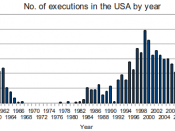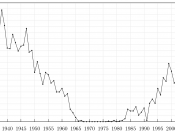One would define capital punishment as the penalty of death for violating a law. Roughly half the nations of the world utilize the death penalty, while the rest eliminated its use. The United States, an industrialized nation, breaks the pattern that only developing countries retain capital punishment ("Capital" Encarta 1). The United States uses five techniques for execution: hanging, firing squad, lethal gas, electrocution, and lethal injection (Snell 16). Of these methods, each result in death for the prisoner in distinct ways.
Before hanging, application of a measuring process, based on weight, yields 1260 foot- pounds of force to the condemned person's neck (Bobit 5). Blindfolded (McCuen 19), the convict stands with a noosed rope or cord ("Hanging" Encarta 1) around their neck, behind the left ear (Bobit 5).
Positioned upon a trap door (McCuen 19) of a gallows, a frame with a crosspiece, the criminal anticipates the sudden drop.
Death can result from compression of the windpipe, obstruction of blood flow, rupture of nerve structures in the neck ("Hanging" Encarta 1), severing of the spinal cord from the brain by dislocating the third and fourth cervical vertebrae, or by asphyxiation. But if not properly performed, strangulation, obstructed blood flow, or even beheading could occur (Bobit 5). In the United States, only three executions by this manner took place, as of 1996, since 1977 (Snell 16).
From 1977 to 1996, the firing squad killed two prisoners (Snell 16). If shot at the head from close range, death occurs almost immediately, for "the bullet penetrates the medulla, which contains the vital respirator and cardiac centers, among others" (McCuen 20). Generally, a team of five executioners take aim at the captive's chest. Some rifles contain a blank so they don't know who really killed the convict (Bobit 4). With the several shots...


